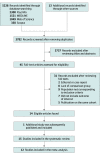Association of Attention-Deficit/Hyperactivity Disorder in Childhood and Adolescence With the Risk of Subsequent Psychotic Disorder: A Systematic Review and Meta-analysis
- PMID: 33625499
- PMCID: PMC7905700
- DOI: 10.1001/jamapsychiatry.2020.4799
Association of Attention-Deficit/Hyperactivity Disorder in Childhood and Adolescence With the Risk of Subsequent Psychotic Disorder: A Systematic Review and Meta-analysis
Abstract
Importance: Growing evidence supports an association between attention-deficit/hyperactivity disorder (ADHD) in childhood and subsequent psychotic disorders. Both disorders share physiopathological features such as attention deficits, dopaminergic imbalance, and genetic susceptibility. However, the results of epidemiologic studies have been conflicting.
Objective: To provide a quantitative synthesis of studies exploring the association between ADHD and the risk of subsequent psychotic disorder.
Data sources: A systematic literature search of the MEDLINE, Scopus, PsycInfo, and Web of Science databases was performed from inception until the final analysis on July 7, 2020. No restriction of language was applied.
Study selection: Cohort and case-control studies examining the relative risk of developing a psychotic disorder in people diagnosed with ADHD at younger than 18 years compared with control individuals without ADHD.
Data extraction and synthesis: Preferred Reporting Items for Systematic Reviews and Meta-analyses (PRISMA) and Meta-analysis of Observational Studies in Epidemiology (MOOSE) guidelines were followed in reporting results. Two independent reviewers extracted the data and assessed the risk of bias of individual studies using the Newcastle-Ottawa Scale. Preferably adjusted odds ratios (aORs) or hazard ratios from the identified studies were extracted, and ORs were computed when they were not adjusted. A random-effects model was used to calculate the pooled relative effect using the meta package in R.
Main outcomes and measures: An association between ADHD (exposure) and psychotic disorder (outcomes); both diagnoses were based on international classification.
Results: A total of 15 studies were included in the review. Twelve studies were pooled in the meta-analysis, representing 1.85 million participants. A diagnosis of ADHD in childhood was associated with a significant increase in the risk of subsequent psychotic disorder, with a pooled relative effect of 4.74 (95% CI, 4.11-5.46; I2 = 43% [95% CI, 0%-70%]). No significant between-group differences were found for subgroup analyses according to psychotic disorder (odds ratio [OR], 5.04; 95% CI, 4.36-5.83) or schizophrenia (OR, 4.59; 95% CI, 3.83-5.50) outcomes, cohort (OR, 4.64; 95% CI, 4.04-5.34) or case-control (OR, 6.81; 95% CI, 4.21-11.03) study design, and adjusted (OR, 4.72; 95% CI, 4.11-5.46) or unadjusted (OR, 3.81; 95% CI, 1.39-10.49) estimates. Meta-regressions were not significant when sex and bias score were used as covariates. No evidence of publication bias was found.
Conclusions and relevance: These findings suggest that childhood ADHD is associated with an increased risk of a subsequent psychotic disorder. Further studies are required to determine the mechanisms linking these common conditions and whether early intervention for ADHD might reduce the risk of subsequent psychotic disorder.
Conflict of interest statement
Figures



Similar articles
-
Association between attention deficit hyperactivity disorder and asthma: a systematic review and meta-analysis and a Swedish population-based study.Lancet Psychiatry. 2018 Sep;5(9):717-726. doi: 10.1016/S2215-0366(18)30224-4. Epub 2018 Jul 24. Lancet Psychiatry. 2018. PMID: 30054261
-
Association of Cesarean Delivery With Risk of Neurodevelopmental and Psychiatric Disorders in the Offspring: A Systematic Review and Meta-analysis.JAMA Netw Open. 2019 Aug 2;2(8):e1910236. doi: 10.1001/jamanetworkopen.2019.10236. JAMA Netw Open. 2019. PMID: 31461150 Free PMC article.
-
Prevalence and comorbidity of attention deficit hyperactivity disorder in Spain: study protocol for extending a systematic review with updated meta-analysis of observational studies.Syst Rev. 2019 Feb 11;8(1):49. doi: 10.1186/s13643-019-0967-y. Syst Rev. 2019. PMID: 30744675 Free PMC article.
-
Attention-deficit/hyperactivity disorder, methylphenidate use and the risk of developing schizophrenia spectrum disorders: A nationwide population-based study in Taiwan.Schizophr Res. 2015 Oct;168(1-2):161-7. doi: 10.1016/j.schres.2015.08.033. Epub 2015 Sep 10. Schizophr Res. 2015. PMID: 26363968
-
Association between childhood asthma and attention deficit hyperactivity or autism spectrum disorders: A systematic review with meta-analysis.Clin Exp Allergy. 2021 Feb;51(2):228-252. doi: 10.1111/cea.13750. Epub 2020 Oct 13. Clin Exp Allergy. 2021. PMID: 32997856
Cited by
-
Developmental perspectives on the origins of psychotic disorders: The need for a transdiagnostic approach.Dev Psychopathol. 2024 Dec;36(5):2559-2569. doi: 10.1017/S0954579424000397. Epub 2024 Feb 26. Dev Psychopathol. 2024. PMID: 38406831 Free PMC article. Review.
-
Editorial: Markers of clinical significance and treatment-seeking of psychotic experiences in non-clinical populations: potential resilience & risk factors.Front Psychiatry. 2025 Feb 5;16:1557770. doi: 10.3389/fpsyt.2025.1557770. eCollection 2025. Front Psychiatry. 2025. PMID: 39975946 Free PMC article. No abstract available.
-
Diagnostic and Therapeutic Challenges of Comorbid ASD, ADHD and Psychosis: A Case Report.Behav Sci (Basel). 2022 Oct 6;12(10):382. doi: 10.3390/bs12100382. Behav Sci (Basel). 2022. PMID: 36285951 Free PMC article.
-
Self-Reported Maternal Parenting Stress From 9 m Is Longitudinally Associated With Child ADHD Symptoms at Age 12: Findings From a Population-Based Birth Cohort Study.Front Psychiatry. 2022 Apr 28;13:806669. doi: 10.3389/fpsyt.2022.806669. eCollection 2022. Front Psychiatry. 2022. PMID: 35573369 Free PMC article.
-
Psychiatric Comorbidities and Schizophrenia in Youths With Attention-Deficit/Hyperactivity Disorder.JAMA Netw Open. 2023 Nov 1;6(11):e2345793. doi: 10.1001/jamanetworkopen.2023.45793. JAMA Netw Open. 2023. PMID: 38032637 Free PMC article.
References
Publication types
MeSH terms
LinkOut - more resources
Full Text Sources
Other Literature Sources
Medical

